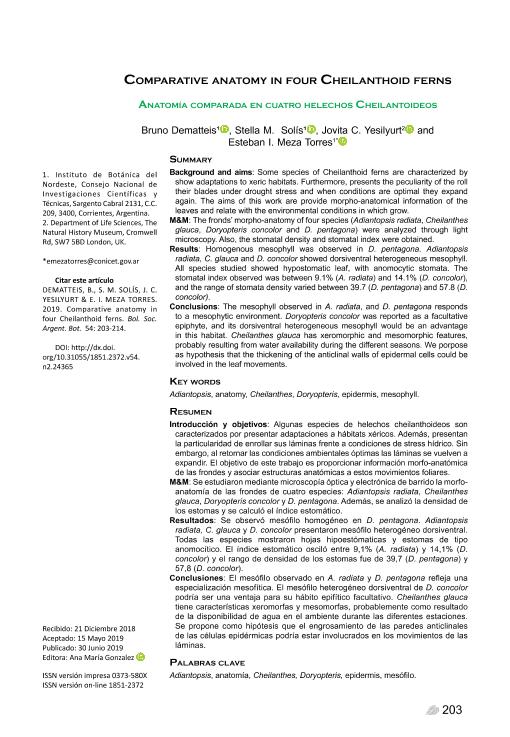Artículo
Background and aims: Some species of Cheilanthoid ferns are characterized by show adaptations to xeric habitats. Furthermore, presents the peculiarity of the roll their blades under drought stress and when conditions are optimal they expand again. The aims of this work are provide morpho-anatomical information of the leaves and relate with the environmental conditions in which grow. M&M: The fronds? morpho-anatomy of four species (Adiantopsis radiata, Cheilanthes glauca, Doryopteris concolor and D. pentagona) were analyzed through light microscopy. Also, the stomatal density and stomatal index were obtained. Results: Homogenous mesophyll was observed in D. pentagona. Adiantopsis radiata, C. glauca and D. concolor showed dorsiventral heterogeneous mesophyll. All species studied showed hypostomatic leaf, with anomocytic stomata. The stomatal index observed was between 9.1% (A. radiata) and 14.1% (D. concolor), and the range of stomata density varied between 39.7 (D. pentagona) and 57.8 (D. concolor). Conclusions: The mesophyll observed in A. radiata, and D. pentagona responds to a mesophytic environment. Doryopteris concolor was reported as a facultative epiphyte, and its dorsiventral heterogeneous mesophyll would be an advantage in this habitat. Cheilanthes glauca has xeromorphic and mesomorphic features, probably resulting from water availability during the different seasons. We porpose as hypothesis that the thickening of the anticlinal walls of epidermal cells could be involved in the leaf movements. Introducción y objetivos: Algunas especies de helechos cheilanthoideos son caracterizados por presentar adaptaciones a hábitats xéricos. Además, presentan la particularidad de enrollar sus láminas frente a condiciones de stress hídrico. Sin embargo, al retornar las condiciones ambientales óptimas las láminas se vuelven a expandir. El objetivo de este trabajo es proporcionar información morfo-anatómica de las frondes y asociar estructuras anatómicas a estos movimientos foliares.
M&M: Se estudiaron mediante microscopía óptica y electrónica de barrido la morfo-anatomía de las frondes de cuatro especies: Adiantopsis radiata, Cheilanthes glauca, Doryopteris concolor, y D. pentagona. Además, se analizó la densidad de los estomas y se calculó el índice estomático.
Resultados: Se observó mesófilo homogéneo en A. radiata y D. pentagona. Cheilanthes glauca y Doryopteris concolor presentaron mesófilo heterogéneo dorsiventral. Todas las especies mostraron hojas hipoestómaticas y estomas de tipo anomocítico. El índice estomático osciló entre 9,1% (A. radiata) y 14,1% (D. concolor) y el rango de densidad de los estomas fue de 39,7 (D. pentagona) y 57,8 (D. concolor).
Conclusiones: El mesófilo observado en A. radiata y D. pentagona refleja la especialización para habitar ambientes mesófilos. El mesófilo heterogéneo dorsiventral de Doryopteris concolor podría ser una ventaja para su hábito epifítico facultativo. Cheilanthes glauca tiene características xeromorfas y mesomorfas, probablemente como resultado de la disponibilidad de agua en el ambiente durante las diferentes estaciones. Se propone como hipótesis que el engrosamiento de las paredes anticlinales de las células epidérmicas podría estar involucrados en los movimientos de las láminas.
Comparative anatomy in four Cheilanthoid ferns
Título:
Anatomía comparada en cuatro helechos Cheilantoideos
Fecha de publicación:
06/2019
Editorial:
Sociedad Argentina de Botánica
Revista:
Boletín de la Sociedad Argentina de Botánica
ISSN:
0373-580X
e-ISSN:
1851-2372
Idioma:
Inglés
Tipo de recurso:
Artículo publicado
Clasificación temática:
Resumen
Palabras clave:
ADIANTOPSIS
,
ANATOMY
,
CHEILANTHES
,
DORYOPTERIS
,
EPIDERMIS
,
MESOPHYLL
Archivos asociados
Licencia
Identificadores
Colecciones
Articulos(IBONE)
Articulos de INST.DE BOTANICA DEL NORDESTE (I)
Articulos de INST.DE BOTANICA DEL NORDESTE (I)
Citación
Dematteis, Bruno; Solis, Stella Maris; Yesilyurt, Jovita C.; Meza Torres, Esteban Ismael; Comparative anatomy in four Cheilanthoid ferns; Sociedad Argentina de Botánica; Boletín de la Sociedad Argentina de Botánica; 54; 2; 6-2019; 203-214
Compartir
Altmétricas




